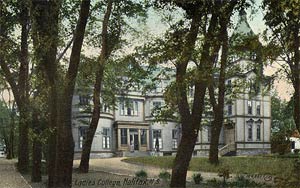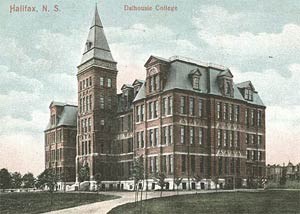 Lucy Maud Montgomery had the time of her life studying English literature at what was then Dalhousie College in 1895-96. Maud, as she was called by her friends, saved her teacher’s salary for an entire year to pay the tuition; she reveled in the challenge of her studies, the intellectually stimulating conversations and the proximity to Point Pleasant Park where she loved to stroll.
Lucy Maud Montgomery had the time of her life studying English literature at what was then Dalhousie College in 1895-96. Maud, as she was called by her friends, saved her teacher’s salary for an entire year to pay the tuition; she reveled in the challenge of her studies, the intellectually stimulating conversations and the proximity to Point Pleasant Park where she loved to stroll.It was a time when her talents as a writer were first being recognized. In one week in 1896, her short stories and poems were accepted in three different publications: “$5 + $5 + $12!” she wrote. “I really feel quite bloated by so much wealth.”
 |
| While attending classes at Dalhousie, Lucy Maud Montgomery boarded at the Halifax Ladies College on Barrington Street. (Nova Scotia Museum collection) |
Her affection for Dalhousie comes through on the pages of her scrapbooks, in the snips of black-and-gold ribbon, newspaper clippings, convocation programs and fin-de-siecle fashion illustrations of women wearing satin gowns with glorious puffed sleeves.
Montgomery scholar Elizabeth Rollins Epperly, a Dal alum herself (MA 1974), writes about the scrapbooks and the profound influence they have on L.M. Montgomery’s fiction, in Imagining Anne (Penguin Canada). Like Budge Wilson’s Before Green Gables, the beautiful book has been released to coincide with the 100th anniversary of Anne of Green Gables.
“She wrote about Dalhousie in her journals and it’s there in her scrapbooks,” says Ms. Epperly—Betsy to her friends. “She looks back on it so fondly. And, of course, she fleshes out the experience in Anne of the Island, calling Dalhousie ‘Redmond College.’ The year she spends at Dalhousie turns into a full-fledged BA for Anne.”
 |
| Dalhousie College in a 1907 postcard. It's now called the Forrest Building. (Nova Scotia Museum collection) |
While at Dalhousie College, L.M. Montgomery boarded at the Halifax Ladies College, an imposing mansion that used to stand on the south-end of Barrington Street. At one point, after a bout of measles, she was moved out of the infirmary to a tiny white room on a floor called “third-and-a-half,” which included only five rooms. Even after she recuperated, she asked to remain.
During the writing of Before Green Gables, Mrs. Wilson and Ms. Epperly discussed the author’s stay at the Halifax Ladies College. And it struck Mrs. Wilson: she believes she stayed in the same room when she was a student at the school half a century later.
“I actually feel shivery thinking of it,” says Mrs. Wilson, whose parents transferred her to the school because she was constantly sick while attending what was then LeMarchant Street School. (Her Grade 2 class there had 66 children compared to the six students at the ladies college.) “The room was very, very white: a white bedspread, white chair, white lamp. If Montgomery was in that room and didn’t want to leave it, she was happy there. I was also so fond of that room. It is still very vivid to me today.”
Mrs. Wilson surmises that when L.M. Montgomery was imagining Anne’s room in Green Gables, she was remembering the little room at the Ladies College. Described at the beginning of the 1908 novel as “painfully bare” and “of a rigidity not to be described in words,” Anne comes to regard the room as a peaceful sanctuary, where she would sit and daydream at the open window.
“I feel in my bones that it was the same room,” says Mrs. Wilson.
Ms. Epperly finds the connection spooky. “I can’t say definitively because I never saw that room. But I think authors have intuition about these things. And I would trust Budge’s instincts on that.”
